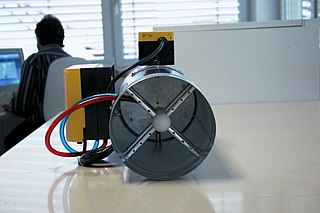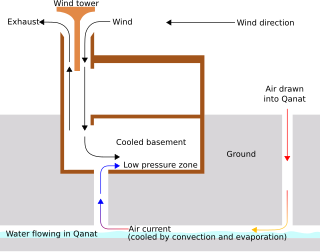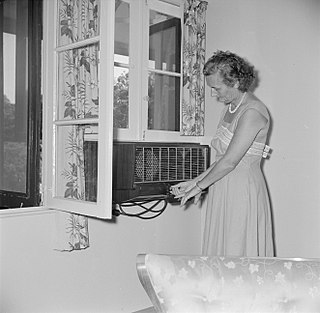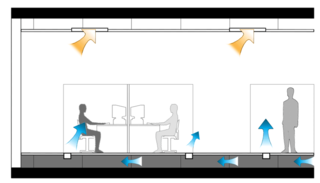Related Research Articles

Heating, ventilation, and air conditioning (HVAC) is the use of various technologies to control the temperature, humidity, and purity of the air in an enclosed space. Its goal is to provide thermal comfort and acceptable indoor air quality. HVAC system design is a subdiscipline of mechanical engineering, based on the principles of thermodynamics, fluid mechanics, and heat transfer. "Refrigeration" is sometimes added to the field's abbreviation as HVAC&R or HVACR, or "ventilation" is dropped, as in HACR.

Ventilation is the intentional introduction of outdoor air into a space. Ventilation is mainly used to control indoor air quality by diluting and displacing indoor pollutants; it can also be used to control indoor temperature, humidity, and air motion to benefit thermal comfort, satisfaction with other aspects of the indoor environment, or other objectives.
A solar chimney – often referred to as a thermal chimney – is a way of improving the natural ventilation of buildings by using convection of air heated by passive solar energy. A simple description of a solar chimney is that of a vertical shaft utilizing solar energy to enhance the natural stack ventilation through a building.

Heat recovery ventilation (HRV), also known as mechanical ventilation heat recovery (MVHR) or energy recovery ventilation (ERV), is a ventilation system that recovers energy by operating between two air sources at different temperatures. It is used to reduce the heating and cooling demands of buildings.

A windcatcher, wind tower, or wind scoop is a traditional architectural element, originated in Iran (Persia), used to create cross ventilation and passive cooling in buildings. Windcatchers come in various designs, depending on whether local prevailing winds are unidirectional, bidirectional, or multidirectional, on how they change with altitude, on the daily temperature cycle, on humidity, and on how much dust needs to be removed. Despite the name, windcatchers can also function without wind.

Variable air volume (VAV) is a type of heating, ventilating, and/or air-conditioning (HVAC) system. Unlike constant air volume (CAV) systems, which supply a constant airflow at a variable temperature, VAV systems vary the airflow at a constant or varying temperature. The advantages of VAV systems over constant-volume systems include more precise temperature control, reduced compressor wear, lower energy consumption by system fans, less fan noise, and additional passive dehumidification.

Underfloor heating and cooling is a form of central heating and cooling that achieves indoor climate control for thermal comfort using hydronic or electrical heating elements embedded in a floor. Heating is achieved by conduction, radiation and convection. Use of underfloor heating dates back to the Neoglacial and Neolithic periods.

Passive cooling is a building design approach that focuses on heat gain control and heat dissipation in a building in order to improve the indoor thermal comfort with low or no energy consumption. This approach works either by preventing heat from entering the interior or by removing heat from the building.

The Center for the Built Environment (CBE) is a research center at the University of California, Berkeley. CBE's mission is to improve the environmental quality and energy efficiency of buildings by providing timely, unbiased information on building technologies and design techniques. CBE's work is supported by a consortium of building industry leaders, including manufacturers, building owners, contractors, architects, engineers, utilities, and government agencies. The CBE also maintains an online newsletter of the center's latest activities called Centerline.

Air conditioning, often abbreviated as A/C (US) or air con (UK), is the process of removing heat from an enclosed space to achieve a more comfortable interior environment and in some cases also strictly controlling the humidity of internal air. Air conditioning can be achieved using a mechanical 'air conditioner' or alternatively a variety of other methods, including passive cooling and ventilative cooling. Air conditioning is a member of a family of systems and techniques that provide heating, ventilation, and air conditioning (HVAC). Heat pumps are similar in many ways to air conditioners, but use a reversing valve to allow them both to heat and to cool an enclosed space.

Passive ventilation is the process of supplying air to and removing air from an indoor space without using mechanical systems. It refers to the flow of external air to an indoor space as a result of pressure differences arising from natural forces.
Room air distribution is characterizing how air is introduced to, flows through, and is removed from spaces. HVAC airflow in spaces generally can be classified by two different types: mixing and displacement.
Air changes per hour, abbreviated ACPH or ACH, or air change rate is the number of times that the total air volume in a room or space is completely removed and replaced in an hour. If the air in the space is either uniform or perfectly mixed, air changes per hour is a measure of how many times the air within a defined space is replaced each hour. Perfectly mixed air refers to a theoretical condition where supply air is instantly and uniformly mixed with the air already present in a space, so that conditions such as age of air and concentration of pollutants are spatially uniform.
HVAC is a major sub discipline of mechanical engineering. The goal of HVAC design is to balance indoor environmental comfort with other factors such as installation cost, ease of maintenance, and energy efficiency. The discipline of HVAC includes a large number of specialized terms and acronyms, many of which are summarized in this glossary.

Underfloor air distribution (UFAD) is an air distribution strategy for providing ventilation and space conditioning in buildings as part of the design of a HVAC system. UFAD systems use an underfloor supply plenum located between the structural concrete slab and a raised floor system to supply conditioned air to supply outlets, located at or near floor level within the occupied space. Air returns from the room at ceiling level or the maximum allowable height above the occupied zone.

A dedicated outdoor air system (DOAS) is a type of heating, ventilation and air-conditioning (HVAC) system that consists of two parallel systems: a dedicated system for delivering outdoor air ventilation that handles both the latent and sensible loads of conditioning the ventilation air, and a parallel system to handle the loads generated by indoor/process sources and those that pass through the building enclosure.
Airflow, or air flow, is the movement of air. The primary cause of airflow is the existence of air. Air behaves in a fluid manner, meaning particles naturally flow from areas of higher pressure to those where the pressure is lower. Atmospheric air pressure is directly related to altitude, temperature, and composition.
The Horizontal Skyscraper, designed by Steven Holl Architects and completed in 2009, is a mixed-use building on the outskirts of Shenzhen, China. It is in Dameisha, Yantian District. The complex includes offices for the Vanke Co., a conference center, restaurant, an auditorium, a hotel, apartments and a large public park.

Cross ventilation is a natural phenomenon where wind, fresh air or a breeze enters upon an opening, such as a window, and flows directly through the space and exits through an opening on the opposite side of the building. This produces a cool stream of air and as well as a current across the room from the exposed area to the sheltered area. Other terms used for the effect include, cross-breeze, cross-draft, wind effect ventilation and cross-flow ventilation.

Ventilative cooling is the use of natural or mechanical ventilation to cool indoor spaces. The use of outside air reduces the cooling load and the energy consumption of these systems, while maintaining high quality indoor conditions; passive ventilative cooling may eliminate energy consumption. Ventilative cooling strategies are applied in a wide range of buildings and may even be critical to realize renovated or new high efficient buildings and zero-energy buildings (ZEBs). Ventilation is present in buildings mainly for air quality reasons. It can be used additionally to remove both excess heat gains, as well as increase the velocity of the air and thereby widen the thermal comfort range. Ventilative cooling is assessed by long-term evaluation indices. Ventilative cooling is dependent on the availability of appropriate external conditions and on the thermal physical characteristics of the building.
References
- ↑ About Mixed Mode, Center for the Built Environment (CBE), University of California, Berkeley, 2005.
- ↑ Bienvenido-Huertas, David; de la Hoz-Torres, María Luisa; Aguilar, Antonio J.; Tejedor, Blanca; Sánchez-García, Daniel (2023-11-01). "Holistic overview of natural ventilation and mixed mode in built environment of warm climate zones and hot seasons". Building and Environment. 245: 110942. doi:10.1016/j.buildenv.2023.110942. ISSN 0360-1323.